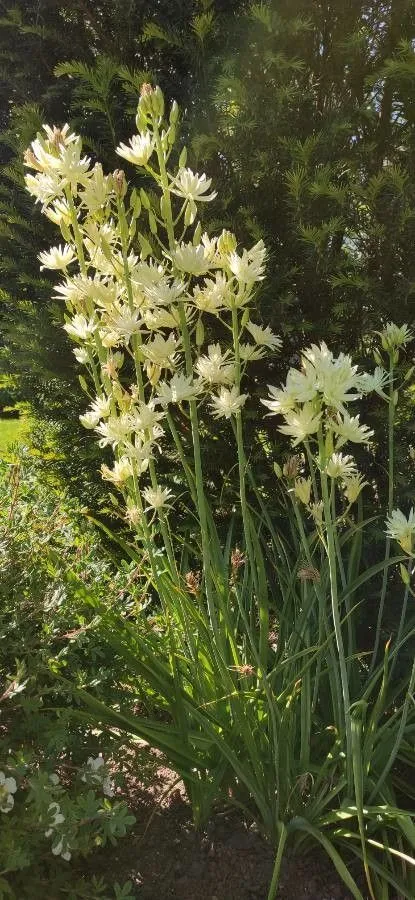
Author: (Baker) S.Watson
Bibliography: Proc. Amer. Acad. Arts 20: 376 (1885)
Year: 1885
Status: accepted
Rank: species
Genus: Camassia
Vegetable: False
Observations: S. British Columbia to C. California
Large camas, known scientifically as Camassia leichtlinii, is a perennial plant belonging to the Asparagaceae family. Described in 1885 under the authorship of (Baker) S. Watson, this striking plant boasts vibrant characteristics and an important ecological presence.
Native to regions spanning from southern British Columbia to central California, Large camas thrives in meadows and grasslands, often flourishing in moist, well-drained soils. This geographical spread underscores its adaptability to different temperate climates within the Pacific Northwest and California.
Large camas is celebrated for its tall, slender spikes that can reach impressive heights, adorned with an abundance of star-shaped flowers that range in color from pale blue to deep violet. These blossoms typically emerge in late spring to early summer, creating a breathtaking display that is not only visually appealing but also beneficial for local pollinators such as bees and butterflies.
This plant holds significant cultural and historical importance. Indigenous peoples of the Pacific Northwest have long utilized Large camas bulbs as a food source, which were traditionally harvested, cooked, and consumed as part of their diet.
Ecologically, Camassia leichtlinii serves as an excellent species for native plant restoration projects and sustainable gardening. Its robust nature and enchanting beauty make it a favored choice among gardeners looking to cultivate a piece of the natural landscape within their own spaces.
In summary, Large camas (Camassia leichtlinii) is a distinguished member of the Asparagaceae family, characterized by its stunning floral display and deep-rooted historical significance, extending its charm and utility from the wild meadows of British Columbia to the valleys of California.
Eng: large camas, great camas, leichtlin’s camas
Swe: mörk stjärnhyacint
Fra: camassie de leichtlin
En: Large camas, Great camas, Leichtlin’s camas
Fr: Camassie de Leichtlin
Sv: Mörk stjärnhyacint
© copyright of the Board of Trustees of the Royal Botanic Gardens, Kew.
© copyright of the Board of Trustees of the Royal Botanic Gardens, Kew.
© copyright of the Board of Trustees of the Royal Botanic Gardens, Kew.
Taken Apr 14, 2020 by Patrice Simon (cc-by-sa)
Taken Apr 12, 2021 by bernard Diederichs (cc-by-sa)
Taken May 19, 2020 by Anton Chi (cc-by-sa)
Taken Jul 27, 2019 by Dieter Wagner (cc-by-sa)
Taken Jul 27, 2019 by Dieter Wagner (cc-by-sa)
Taken May 6, 2021 by Cécile LM (cc-by-sa)
Taken May 22, 2022 by Samuel Hawksby-Robinson (cc-by-sa)
Taken May 31, 2021 by Dieter Albrecht (cc-by-sa)
Taken Apr 30, 2021 by K Desvignes (cc-by-sa)
Taken May 18, 2021 by _Blümchen_ (cc-by-sa)
Taken Jun 11, 2021 by Dieter Albrecht (cc-by-sa)
Taken May 9, 2020 by amal sayed (cc-by-sa)
Taken Jun 8, 2020 by babe preyer (cc-by-sa)
Taken Jun 15, 2022 by AMANDA BRAND (cc-by-sa)
Taken May 19, 2021 by Plantlord Rock (cc-by-sa)
Taken Apr 30, 2021 by K Desvignes (cc-by-sa)
Taken May 18, 2021 by _Blümchen_ (cc-by-sa)
Growth habit>: Forb/herb
Family: Myrtaceae Author: (F.Muell.) K.D.Hill & L.A.S.Johnson Bibliography: Telopea 6: 402 (1995) Year: 1995 Status:…
Family: Rubiaceae Author: Pierre ex A.Froehner Bibliography: Notizbl. Bot. Gart. Berlin-Dahlem 1: 237 (1897) Year:…
Family: Sapindaceae Author: Koidz. Bibliography: J. Coll. Sci. Imp. Univ. Tokyo 32(1): 38 (1911) Year:…
Family: Asteraceae Author: A.Gray Bibliography: Pacif. Railr. Rep.: 107 (1857) Year: 1857 Status: accepted Rank:…
Family: Fabaceae Author: Medik. Bibliography: Vorles. Churpfälz. Phys.-Ökon. Ges. 2: 398 (1787) Year: 1787 Status:…
Family: Aspleniaceae Author: (Cav.) Alston Bibliography: Bull. Misc. Inform. Kew 1932: 309 (1932) Year: 1932…